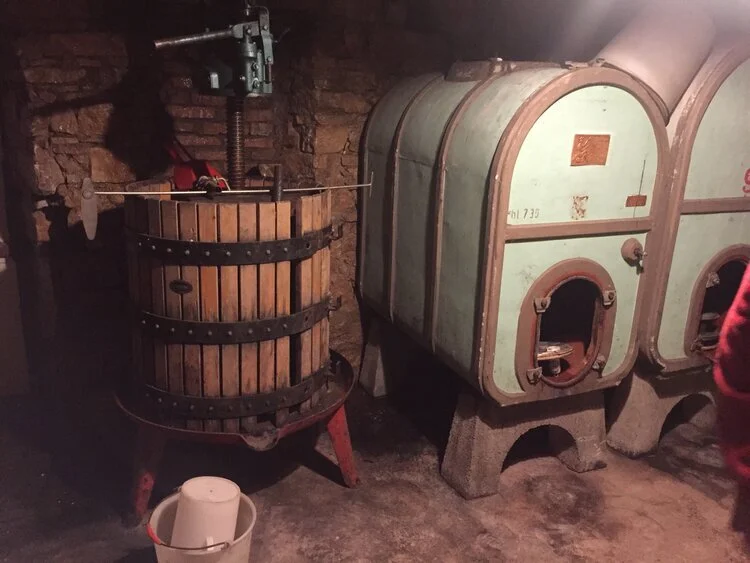Azienda Agricola Divella - Lombardia, Italy
alessandra divella, gussago, franciacorta area, italy
A FINGERPRINT OF A PLACE... GUSSAGO
Alessandra Divella makes wine in Gussago, a small village on the rim of the amphitheater of Franciacorta. Alessandra does not call her wines Franciacorta although, like the wines of Franciacorta, they are sparkling. She calls them Gussago.
As winedrinkers, we are opening up to the idea that sparkling wines can be wines of place. The grower-lead revolution in Champagne shows us that the chalk soils of Ambonnay make more bracing wines than the generous clay soils of the Aube. In almost every part of Italy, delightful sparkling wine is produced — (better than anyone gives it credit for). There are few formalized micro-regional distinctions, but the farmers know where the good stuff grows.
Great wine announces itself through the murmuring hush of a room arguing about borders. With or without borders, these wines remain untangled. They speak through the calm, bright diction of living soil. The first sip of Divella’s wine will present you with some new textural information: a fingerprint of a place you’ve never been, called Gussago.
Gussago is right down the road (just 2 kilometers) from Cellatica. Bubbleheads will remember that Cellatica is where Antonio and Flavio at Cà del Vent are making Italy’s best sparkling wine. Cellatica and Gussago are singular territories of Franciacorta in that they contain some of the only limestone-chalk of the region. Underground springs beneath the region, connected with the lakes in the Brescian foothills of the Alps directly to the north, created this limestone soil slowly through the course of hundreds of years. These minerals in the soil of this corner of NE Franciacorta come out evidently in the wine — there is a harmony between bubble and texture that is not found in other parts of the region.
So you see where boundaries create a tangle for those who wish to create something that isn’t like the others: Divella and Cà del Vent respectively believe it is wrong for them to put Franciacorta on the labels, that Franciacorta represents something else. Alessandra graciously bucks convention. She has never put Franciacorta on her labels. She doesn’t need to. And if she and Antonio and others in their region keep up their hard work, in time, names like Cellatica and Gussago will draw cups of sparkling wines to our mouths.
“I like wines that are missing something.”
Alessandra says so during our tasting as she siphons a silky cylinder from a barrel into my glass. I’m surprised by her bluntness: this statement is a challenge and reflects a courage. It’s not something many winemakers say — most, even those working within a “natural” register, hope to make something that reaches its own completion, that speaks in its own fullness. But wine is a living thing, and sometimes living things do not comb their hair. They look so beautiful when they come in from the windy weather that we wonder who is the lunatic in all time that invented the comb?
Alessandra’s project proposes we delve into time in a few different ways. First, we must be patient with the wines that are missing something as they often resolve themselves. Second, the things we accept as “conventional” are not as old as we think. There might be pleasure to be gained from looking further back at other conventions, both for the maker and the drinker.
The wine she poured into my glass was all chardonnay from two vintages prior. It was a muted glow, like that Patti Smith lyric — like someone had spread butter on all the fine points of the stars. The acid of the wine was not clear at first, but emerged after the rest of the texture of the wine unfolded. She told me how it was finally hitting its stride, how it changed while she was not paying attention (hard to believe). It was not a finished wine (not for Franciacorta, as it had not gone through its second fermentation yielding bubbles), but it was a wine missing something. In missing something, it was filled with energy and desire. I understood. What does our enjoyment of wine look like if we know that the substances we drink will change? What if we are habituated to a little more honesty from the things we consume?
The techniques she employs in the winery have more to do with producers in Champagne she admires than they do classic Franciacorta techniques. There is not a stainless steel tank in the entire winery — a true rarity for this region (though not, again, for this part of Franciacorta — Cà del Vent also uses all barrique for their winemaking). If you are to ask Alessandra why she does this, part of her reason is the wine of Anselme Selosse, a great Champagne winemaker who ferments exclusively in oak barrels. This is another aspect of Divella’s modernity — her influences are far and wide, not confined by the tradition of the region. She decided that she loved these wines and decided to try to replicate with her own technique what she loved about them. Every wine is made without dosage — shocking in Franciacorta where most wines are souped up majorly with sugar at every part of the winemaking process. Without dosage, they show more of the vintage and more of the place.
in the divella cellar
The differences in Divella’s wines are with assemblage, not with technique in vinification. All of the wines are destemmed and then pressed in an old-fashioned basket press, initially fermented in cement and wood, and all finish first fermentation in neutral barrique and barrels. The wine is all made in metodo classico style — that is, identical to how Champagne is made. There are minuscule doses of sulfur added and no dosage added.
Alessandra’s farming and winemaking are rustic. Her vineyards are organic and spread between the villages of Gussago and Cellatica. 1.5 of her hectares are chardonnay, the remaining 0.5 hectare parcel is pinot noir. Alessandra does not own these vineyards but leases them from a family who planted them about 20-25 years ago. She may eventually take over these vines. She sprays copper and sulfur only when strictly needed in the vineyard. Her farming looks to permaculture for instruction and guidance and hope to honor the biodiversity of the region.
Cellatica and Gussago are the windy highlands of Franciacorta. Importantly, they are very well-ventilated areas — a huge advantage in the region, where most vineyards are planted at low-elevation where humidity notoriously gets trapped and can wreck a year’s crop. As Antonio of Cà del Vent has pointed out, this region has evidence of some of the earliest plantings in the whole region — the old timers had a sense that this was the best place, too.
Alessandra is daring, direct, and quietly hilarious. She has taught herself a lot of what she knows — she is not from a winemaking family but has made this her life. Some of her learning has come from working in wineries in the area, some of her learning has come from iconic Champagne producers — thrillingly, a lot of her learning is still playing out in time. Today she is in the process of building out the rest of the stone house that she makes her wine in and eventually making a red still wine inspired by Coteaux Champenois from a vineyard right outside the house. There is a lot of life in what she does.
I regret that I got there very late on a sonorously raining night and could not see the vineyards. Someone from Team E&R will return this year. We love Gussago and Cellatica and other producers in and decidedly not in Franciacorta — Cà del Vent, Cola Battista, Corte Fusia, soon more.
________________________
I woke up in Venice the morning of the endless magical day I visited Divella. Some of the precious non-wine hours of the trip on the days before were spent wandering the Venice biennale. In one pavillion was a piece by artist Shilpa Gupta (“For, in your tongue, I cannot fit.”), a grid of railroad spikes, paper sheets of poetry stabbed over the top of them. All the poems were written by poets detained at borders, among them, people we know, people whose language we speak, others we don’t. Above the grid of spikes voices were played reading the poems and gallery walkers moved through the space, words becoming human as the words were read by humans. Words whose beauty partially comes from what they do not or cannot say, what they are missing, like Seamus Heaney:
Useless to think you’ll park and capture it
More thoroughly. You are neither here nor there,
A hurry through which known and strange things
pass
As big soft buffetings come at the car sideways
And catch the heart off guard and blow it open.
I thought about how the borders we make around spaces are useful until they are not. Franciacorta's border around what is an acceptable wine. My own border of personal understanding around Divella and around the Gupta exhibit — does it do anything to help you understand? In wine today some of the most brilliant winemakers get tangled up in the stupidity of the rules just as poets we love get trapped at the border, arrested, detained, forgotten, wine confiscated. There are sad stories and there are also victories. Divella is a victory.
Click on each wine for more detail.






